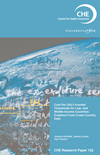Cost per DALY averted thresholds for low- and middle-income countries: evidence from cross country data
Posted on 15 December 2015

Low- and middle-income countries (LMICs) face difficult decisions about which health care interventions are worthwhile given existing constraints on health care expenditure. Decisions require some assessment of the health opportunity costs of proposed investments, i.e., a ‘supply side’ cost-effectiveness threshold (CET) that represents the likely health effects of changes in health care expenditure.
This paper provides a framework for generating country-level CETs using existing published estimates of the mortality effect of health expenditure. Two different estimation strategies are used and, where possible, estimation is extended to include other measures of mortality, survival and disability outcomes, reflecting the demographic and other characteristics of each LMIC.
The results suggest that CETs representing likely health opportunity costs tend to be below the lower bound suggested by WHO of 1x GDP per capita. Hence, many previous and existing recommendations about which interventions are cost-effective that are based on the WHO threshold are likely to do more harm than good.
Full report: CHE Research Paper 122 (PDF ![]() , 2,322kb)
, 2,322kb)
Other papers in the CHE Research paper series can be found at: In house publications

